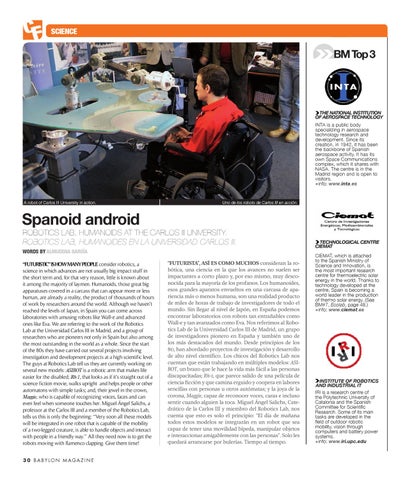DESIGN LITERATURE SCIENCE
BM Top 3
THE NATIONAL INSTITUTION OF AEROSPACE TECHNOLOGY INTA is a public body specializing in aerospace technology research and development. Since its creation, in 1942, it has been the backbone of Spanish aerospace activity. It has its own Space Communications complex, which it shares with NASA. The centre is in the Madrid region and is open to visitors. +info: www.inta.es
A robot of Carlos III University in action.
Uno de los robots de Carlos III en acción.
Spanoid android
ROBOTICS LAB, HUMANOIDS AT THE CARLOS III UNIVERSITY. ROBOTICS LAB, HUMANOIDES EN LA UNIVERSIDAD CARLOS III. WORDS BY ALMUDENA GARCÍA “FUTURISTIC”ISHOWMANYPEOPLE consider robotics, a science in which advances are not usually big impact stuff in the short term and, for that very reason, little is known about it among the majority of laymen. Humanoids, those great big apparatuses covered in a carcass that can appear more or less human, are already a reality, the product of thousands of hours of work by researchers around the world. Although we haven’t reached the levels of Japan, in Spain you can come across laboratories with amusing robots like Wall-e and advanced ones like Eva. We are referring to the work of the Robotics Lab at the Universidad Carlos III in Madrid, and a group of researchers who are pioneers not only in Spain but also among the most outstanding in the world as a whole. Since the start of the 80s they have carried out several projects involving investigation and development projects at a high scientific level. The guys at Robotics Lab tell us they are currently working on several new models: ASIBOT is a robotic arm that makes life easier for the disabled; Rh-1, that looks as if it’s straight out of a science fiction movie, walks upright and helps people or other automatons with simple tasks; and, their jewel in the crown, Maggie, who is capable of recognizing voices, faces and can even feel when someone touches her. Miguel Ángel Salichs, a professor at the Carlos III and a member of the Robotics Lab, tells us this is only the beginning: “Very soon all these models will be integrated in one robot that is capable of the mobility of a two-legged creature, is able to handle objects and interact with people in a friendly way.” All they need now is to get the robots moving with flamenco clapping. Give them time! 3 0 B A BY L O N M A G A Z I N E
“FUTURISTA”, ASÍ ES COMO MUCHOS consideran la robótica, una ciencia en la que los avances no suelen ser impactantes a corto plazo y, por eso mismo, muy desconocida para la mayoría de los profanos. Los humanoides, esos grandes aparatos envueltos en una carcasa de apariencia más o menos humana, son una realidad producto de miles de horas de trabajo de investigadores de todo el mundo. Sin llegar al nivel de Japón, en España podemos encontrar laboratorios con robots tan entrañables como Wall-e y tan avanzados como Eva. Nos referimos al Robotics Lab de la Universidad Carlos III de Madrid, un grupo de investigadores pionero en España y también uno de los más destacados del mundo. Desde principios de los 80, han abordado proyectos de investigación y desarrollo de alto nivel científico. Los chicos del Robotics Lab nos cuentan que están trabajando en múltiples modelos: ASIBOT, un brazo que le hace la vida más fácil a las personas discapacitadas; Rh-1, que parece salido de una película de ciencia ficción y que camina erguido y coopera en labores sencillas con personas u otros autómatas; y la joya de la corona, Maggie, capaz de reconocer voces, caras e incluso sentir cuando alguien la toca. Miguel Ángel Salichs, Catedrático de la Carlos III y miembro del Robotics Lab, nos cuenta que esto es solo el principio: “El día de mañana todos estos modelos se integrarán en un robot que sea capaz de tener una movilidad bípeda, manipular objetos e interaccionar amigablemente con las personas”. Solo les quedará arrancarse por bulerías. Tiempo al tiempo.
TECHNOLOGICAL CENTRE CIEMAT CIEMAT, which is attached to the Spanish Ministry of Science and Innovation, is the most important research centre for thermoelectric solar energy in the world. Thanks to technology developed at the centre, Spain is becoming a world leader in the production of thermo solar energy. (See BM#7, Ecolab, page 48.) +info: www.ciemat.es
INSTITUTE OF ROBOTICS AND INDUSTRIAL IT IRI is a research centre of the Polytechnic University of Catalonia and the Spanish Committee for Scientific Research. Some of its main tasks are developed in the field of outdoor robotic mobility, vision through computers and battery power systems. +info: www.iri.upc.edu
